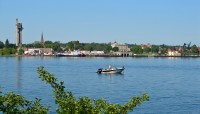-
Your guide to Sault St. Marie, Michigan assisted living facilities. With so many senior housing options available, how do you know which one is right for your family?
Our Senior Living Advisors live in the Sault St. Marie area and can provide you with an insider's view of local communities including pricing information and distinctive features.
Request information online by filling out the form to the right or call us at 855-363-2002 for a no-cost, in-depth assessment of your senior care needs. Our compassionate advisors can help you find the best Sault St. Marie assisted living facilities for your unique needs and budget.
The official website for the city of Sault St. Marie is http://www.saultcity.com.
-
Assisted Living Costs in Nearby Cities
* The costs above represent the AVERAGE monthly cost of assisted living for a one person bedroom in that city. -
Facts about Sault St. Marie
Sault St. Marie is also known as: Sault Ste. Marie, Michigan and Chippewa County / Sault Ste. Marie city.
And some of the notable people born here have been: Brigitte Acton (alpine skier), Kathleen Sullivan (lawyer), Jeff Blashill (coach), Ray Kaunisto (ice hockey player and athlete), and Terry O'Quinn (actor).
And featured attractions of Sault St. Marie: Old Fort Brady, Elmwood, St. Mary's Pro-Cathedral, Chippewa County Courthouse, and John Johnston House.
Sault St. Marie is represented by City Manager Oliver Turnerand Mayor Anthony Bosbous.
Sault Ste. Marie is a city in, and the county seat of, Chippewa County in the U.S. state of Michigan. It is situated on the northeastern end of Michigan's Upper Peninsula, on the Canadian border, and separated from its twin city of Sault Ste. Marie, Ontario, by the St. Marys River. The city is relatively isolated from other communities in Michigan and is 346 miles from Detroit. The population was 14,144 at the 2010 census, making it the second most populous city in the Upper Peninsula. By contrast, the Canadian Sault Ste. Marie is much larger, with more than 75,000 residents, based on more extensive industry developed in the 20th century and an economy with closer connections to other communities.Sault Ste. Marie had been settled by Native Americans more than 500 years ago and was a crossroads of fishing and trading of tribes around the Great Lakes. It developed as the first European settlement in the region that became the Midwestern United States, when, in 1668, Father Jacques Marquette, a French Jesuit, learned of the Native American village and traveled there to found a Catholic mission. French colonists later established a fur trading post, which attracted trappers and Native Americans on a seasonal basis. Both Metis men and women were active in the trade and among the elite in the community. A fur-trading settlement quickly grew at the crossroads that straddled the banks of the river. It was the center of a trading route of 3,000 miles which takes place annually and draws participants and spectators from all over the U.S. and Canada. The race, which was inspired by the Indianapolis 500, originated in 1969 and has been growing ever since.
-
Population shifts in Sault St. Marie
-
Average temperatures in Sault St. Marie
Line in orange is average highs...line in blue is average lows.
Average rainfall in Sault St. Marie
Assisted Living in Sault St. Marie, MI
Sault St. Marie Michigan Assisted Living Facilities
Other communities in Sault St. Marie
If you represent a community listed above and would like to claim your listing, please contact us.

